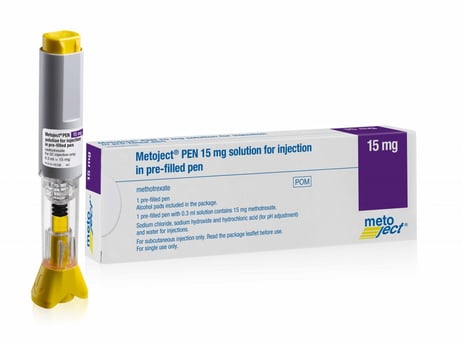We need the prefilled Methotrexate subcutaneous injection pen in Australia!

The take-home message from the recent EULAR congress in London for me was that I should be using subcutaneous Methotrexate (MTX) more.
There was of course lots of other interesting stuff but perhaps my mind was focused by the coverage back home in Australia regarding the deaths on MTX due to overdosing.
I attended a whole session on MTX and how to optimize it's use in rheumatology.
I particularly enjoyed the talk by Michael Schiff and summarise some key points:
- The amount of MTX you absorb and which is then available for use by the body (this is referred to as bioavailability) starts to plateau around 15mg daily so this means that progressively higher doses of MTX may not give much more effect (the risk of side effects is higher at higher doses).
- The bioavailability of MTX given subcutaneously is better than when given orally. This means that a 20mg dose given as oral tablets is likely to have less effect than 20mg of MTX given as a subcutaneous injection.
- There have been studies showing that people with rheumatoid arthritis whose disease is not sufficiently controlled on oral MTX have subsequently improved when the method of MTX administration was changed, that is from oral to a subcutaneous injection.
- Splitting the oral dose does improve the bioavailability and this is sometimes done by Rheumatologists. For eg, take 10mg on Sunday night and have the other 10mg dose on Monday, instead of taking the full 20mg on the Sunday night. Splitting the dose is attractive except that we try to avoid this for fear of confusing patients and potentially leading to mistakes in dosing.
All this has been known for awhile. In Europe and North America, subcutaneous MTX is used a lot more than in Australia. In discussions with some of my Northern hemisphere colleagues, I found out that some rheumatology departments actually even start with subcutaneous MTX rather than oral.
Of course, people do prefer the convenience of tablets. But, my colleagues rightfully point out that given our focus is rapid, effective control of disease in rheumatoid arthritis (the window of opportunity), time taken to explain this to people will lead to acceptance. Better disease control upfront means less progression and less need potentially for upscaling of treatment. We might even reduce the number of people who need much more expensive medications such as the biologic DMARDs.
Yet, I and I think many of my Australian colleagues use much less subcutaneous MTX.
Why?
Well, we don't actually have a convenient way to provide it.
The formulation you can pick up from a standard pharmacy here comes in a vial. You then have to draw up the correct volume using a syringe and needle, and then inject that amount. Many patients choose not to do this themselves so they have to present to their local general practice once weekly for this injection. Wasted time, wasted resources.
There are some specialty pharmacists that can create pre-filled syringes that they then provide to patients. These are less easy to find. Inconvenience equates to less use.
So, we do need the prefilled Methotrexate subcutaneous injection pen in Australia! It's available overseas, prepackaged in a range of doses.

(image accessed from http://www.scottishpharmacist.co.uk/metoject-pen-replaces-discontinued-metoject-syringe/)
An injection pen is very much harder to accidentally use daily rather than once a week.
The risk of overdosing will be very much reduced.
It will save those already having injections time and would seemingly save our Medicare system some overusage and money.
Do you not agree?


